
Parking sensors are proximity sensors for road vehicles designed to alert the driver of obstacles while parking. These systems use either electromagnetic or ultrasonic sensors.

Parking sensors are proximity sensors for road vehicles designed to alert the driver of obstacles while parking. These systems use either electromagnetic or ultrasonic sensors.
These systems feature ultrasonic proximity detectors to measure the distances to nearby objects via sensors located in the front and/or rear bumper fascias or visually minimized within adjacent grills or recesses.
The sensors emit acoustic pulses, with a control unit measuring the return interval of each reflected signal and calculating object distances. [1] The system in turns warns the driver with acoustic tones, the frequency indicating object distance, with faster tones indicating closer proximity and a continuous tone indicating a minimal pre-defined distance. Systems may also include visual aids, such as LED or LCD readouts to indicate object distance. A vehicle may include a vehicle pictogram on the car's infotainment screen, with a representation of the nearby objects as coloured blocks.
Rear sensors may be activated when reverse gear is selected and deactivated as soon as any other gear is selected. Front sensors may be activated manually and deactivated automatically when the vehicle reaches a pre-determined speed to avoid subsequent nuisance warnings.
As an ultrasonic systems relies on the reflection of sound waves, the system may not detect flat objects or object insufficiently large to reflect sound (e.g., a narrow pole or a longitudinal object pointed directly at the vehicle or near an object). Objects with flat surfaces angled from the vertical may deflect return sound waves away from the sensors, hindering detection. Also soft object with strong sound absorption may have weaker detection, e.g. wool or moss.
The electromagnetic parking sensor (EPS) was re-invented and patented in 1992 by Mauro Del Signore. [2] Electromagnetic sensors rely on the vehicle moving slowly and smoothly towards the object to be avoided. Once an obstacle is detected, the sensor continues to signal the presence of the obstacle even if the vehicle momentarily stops. If the vehicle then resumes moving backwards the alarm signal becomes louder as the obstacle is approached. Electromagnetic parking sensors are often sold as not requiring any holes to be drilled offering a unique design that discreetly mounts on the inner side of the bumper preserving the 'new factory look' of your vehicle.
Blind spot monitors are an option that may include more than monitoring the sides of the vehicle. It can include "Cross Traffic Alert," which alerts drivers of oncoming traffic behind them while backing out of a parking space. [3] [4] [5]
In the United States, backup cameras have been required on all new cars since 2018. [6]
Toyota introduced ultrasonic Back Sonar on the 1982 Toyota Corona, offering it until 1988. [7] On December 13, 1984, Massimo Ciccarello and Ruggero Lenci (see List of Italian inventors) entered in Italy the patent request for ultrasonics Parking sensors, and on November 16, 1988, the Ministry of Industry granted them the Patent for industrial invention n. 1196650. [8]
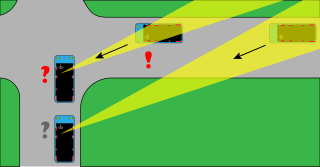
A blind spot in a vehicle or vehicle blind spot is an area around the vehicle that cannot be directly seen by the driver while at the controls, under existing circumstances. In transport, driver visibility is the maximum distance at which the driver of a vehicle can see and identify prominent objects around the vehicle. Visibility is primarily determined by weather conditions and by a vehicle's design. The parts of a vehicle that influence visibility include the windshield, the dashboard and the pillars. Good driver visibility is essential to safe road traffic.

An advanced driver-assistance system (ADAS) includes technologies that assist drivers with the safe operation of a vehicle. Through a human-machine interface, ADAS increases car and road safety. ADAS uses automated technology, such as sensors and cameras, to detect nearby obstacles or driver errors, and respond accordingly. ADAS can enable various levels of autonomous driving.
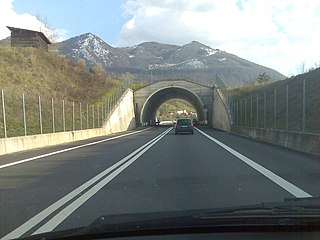
In road-transport terminology, a lane departure warning system (LDWS) is a mechanism designed to warn the driver when the vehicle begins to move out of its lane on freeways and arterial roads. These systems are designed to minimize accidents by addressing the main causes of collisions: driver error, distractions and drowsiness. In 2009 the U.S. National Highway Traffic Safety Administration (NHTSA) began studying whether to mandate lane departure warning systems and frontal collision warning systems on automobiles.

Intelligent Parking Assist System (IPAS), also known as Advanced Parking Guidance System (APGS) for Toyota models in the United States, is the first production automatic parking system developed by Toyota Motor Corporation in 1999 initially for the Japanese market hybrid Prius models and Lexus models. The technology assists drivers in parking their vehicle. On vehicles equipped with the IPAS, via an in-dash screen and button controls, the car can steer itself into a parking space with little input from the user. The first version of the system was deployed on the Prius Hybrid sold in Japan in 2003. In 2006, an upgraded version debuted for the first time outside Japan on the Lexus LS luxury sedan, which featured the automatic parking technology among other brand new inventions from Toyota. In 2009, the system appeared on the third generation Prius sold in the U.S. In Asia and Europe, the parking technology is marketed as the Intelligent Park Assist System for both Lexus and Toyota models, while in the U.S. the Advanced Parking Guidance System name is only used for the Lexus system.

A rear-view mirror is a, usually flat, mirror in automobiles and other vehicles, designed to allow the driver to see rearward through the vehicle's rear window.
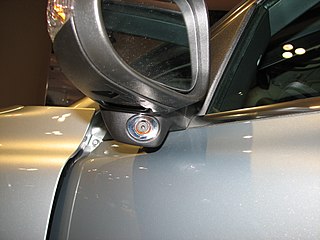
The blind spot monitor or blind-spot monitoring is a vehicle-based sensor device that detects other vehicles located to the driver’s side and rear. Warnings can be visual, audible, vibrating, or tactile.

Automatic parking is an autonomous car-maneuvering system that moves a vehicle from a traffic lane into a parking spot to perform parallel, perpendicular, or angle parking. The automatic parking system aims to enhance the comfort and safety of driving in constrained environments where much attention and experience is required to steer the car. The parking maneuver is achieved by means of coordinated control of the steering angle and speed which takes into account the actual situation in the environment to ensure collision-free motion within the available space.

A backup camera is a video camera that is produced specifically for the purpose of being attached to the rear of a vehicle to aid in backing up and to reduce the rear blind spot. The rear blind spot has been described as a "killing zone" because of the accidents it contributes to. Backup cameras are usually connected to the vehicle's head unit display. A common variant is a surround-view system, which assembles a synthetic but positionally accurate top-down view of the vehicle and its adjacencies.

A side-view mirror, also known as a wing mirror, is a mirror placed on the exterior of motor vehicles for the purposes of helping the driver see areas behind and to the sides of the vehicle, outside the driver's peripheral vision.

Curb feelers or curb finders are springs or wires installed on a vehicle that act as "whiskers" to alert drivers when they are at the right distance from the curb while parking.

A proximity sensor is a sensor able to detect the presence of nearby objects without any physical contact.

Vehicle safety technology (VST) in the automotive industry refers to the special technology developed to ensure the safety and security of automobiles and their passengers. The term encompasses a broad umbrella of projects and devices within the automotive world. Notable examples of VST include geo-fencing capabilities, remote speed sensing, theft deterrence, damage mitigation, vehicle-to-vehicle communication, and car-to-computer communication devices which use GPS tracking.

Reversing is the process of driving a vehicle in the reverse direction in order to maneuver. Rear view mirrors are somewhat standard equipment for this endeavor. Extremely large or luxury vehicles may have in addition technical aids such as backup cameras. Many industrial vehicles such as fork lifts automatically activate a repetitive warning beep whilst reversing. In the UK lorries may be fitted with warning devices which repeatedly announce "Attention: this vehicle is reversing", or the equivalent phrase in Welsh: "Sylw: mae'r Saeson wedi dwyn ein gwlad".

The driver monitoring system, also known as driver attention monitor, is a vehicle safety system to assess the driver's alertness and warn the driver if needed and eventually apply the brakes. It was first introduced by Toyota in 2006 for its and Lexus' latest models. It was first offered in Japan on the GS 450h. The system's functions co-operate with the pre-collision system (PCS). The system uses infrared sensors to monitor driver attentiveness. Specifically, the driver monitoring system includes a CCD camera placed on the steering column which tracks the face, via infrared LED detectors. If the driver is not paying attention to the road ahead and a dangerous situation is detected, the system will warn the driver by flashing lights, warning sounds. If no action is taken, the vehicle will apply the brakes. This system is said to be the first of its kind.

A collision avoidance system (CAS), also known as a pre-crash system, forward collision warning system (FCW), or collision mitigation system, is an advanced driver-assistance system designed to prevent or reduce the severity of a collision. In its basic form, a forward collision warning system monitors a vehicle's speed, the speed of the vehicle in front of it, and the distance between the vehicles, so that it can provide a warning to the driver if the vehicles get too close, potentially helping to avoid a crash. Various technologies and sensors that are used include radar (all-weather) and sometimes laser (LIDAR) and cameras to detect an imminent crash. GPS sensors can detect fixed dangers such as approaching stop signs through a location database. Pedestrian detection can also be a feature of these types of systems.

The phrase "objects in (the) mirror are closer than they appear" is a safety warning that is required to be engraved on passenger side mirrors of motor vehicles in many places such as the United States, Canada, Nepal, India, and South Korea. It is present because while these mirrors' convexity gives them a useful field of view, it also makes objects appear smaller. Since smaller-appearing objects seem further away than they actually are, a driver might make a maneuver such as a lane change assuming an adjacent vehicle is a safe distance behind, when in fact it is quite a bit closer. The warning serves as a reminder to the driver of this potential problem.
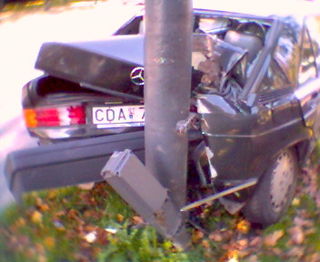
Back-up collisions happen when a driver reverses the car into an object, person, or other car. Although most cars come equipped with rear view mirrors which are adequate for detecting vehicles behind a car, they are inadequate on many vehicles for detecting small children or objects close to the ground, which fall in the car's blind spot, particularly directly aft. That area has been called a "killing zone." Large trucks have much larger blind spots that can hide entire vehicles and large adults.
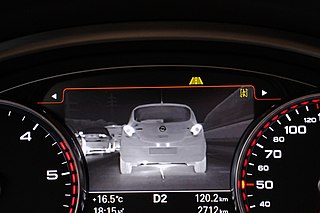
An automotive night vision system uses a thermographic camera to increase a driver's perception and seeing distance in darkness or poor weather beyond the reach of the vehicle's headlights. Such systems are offered as optional equipment on certain premium vehicles. The technology was first introduced in the year 2000 on the Cadillac Deville. This technology is based on the night vision devices (NVD), which generally denotes any electronically enhanced optical devices operate in three modes: image enhancement, thermal imaging, and active illumination. The automotive night vision system is a combination of NVDs such as infrared cameras, GPS, Lidar, and Radar, among others to sense and detect objects.

Electric vehicle warning sounds are sounds designed to alert pedestrians to the presence of electric drive vehicles such as hybrid electric vehicles (HEVs), plug-in hybrid electric vehicles (PHEVs), and battery electric vehicles (BEVs) travelling at low speeds. Warning sound devices were deemed necessary by some government regulators because vehicles operating in all-electric mode produce less noise than traditional combustion engine vehicles and can make it more difficult for pedestrians and cyclists to be aware of their presence. Warning sounds may be driver triggered or automatic at low speeds; in type, they vary from clearly artificial to those that mimic engine sounds and those of tires moving over gravel.
Omniview technology is a vehicle parking assistant technology that first was introduced in 2007 as the "Around View Monitor" option for the Nissan Elgrand and Infiniti EX. It is designed to assist drivers in monitoring their surroundings, for example, while parking a vehicle in a small space.